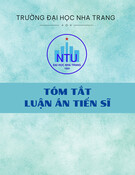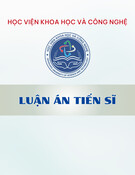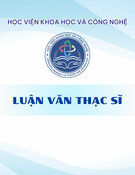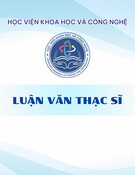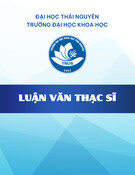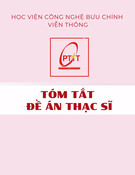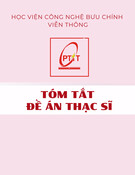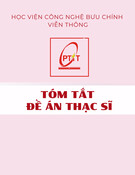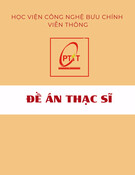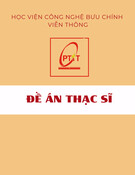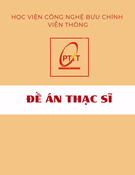
MINISTRY OF
EDUCATION AND
TRAINING
VIETNAM ACADEMY
OF SCIENCE AND
TECHNOLOGY
GRADUATE UNIVERSITY SCIENCE AND
TECHNOLOGY
----------------------------
Bach Ngoc Minh
RESEARCH AND RECEIVING PROTEIN FROM
BRACKISH WATER ALGAE (Chaetomorpha sp.)
FOR APPLICATION IN FOOD INDUSTRY
Major: Biotechnology
Code: 9 42 02 01
SUMMARY OF BIOTECHNOLOGY DOCTORAL
THESIS
Ho Chi Minh City – 2020

The thesis is completed at: Ministry of Education and Training
– Vietnam Academy of Science and Technology.
Supervisors 1: Assoc. Prof., Dr. Hoang Kim Anh
Supervisors 2: Assoc. Prof., DSc. Ngo Ke Suong
Reviewer 1: …
Reviewer 2: …
Reviewer 3: ….
The thesis shall be defended in front of the Thesis Committee
at Ministry of Education and Training – Vietnam Academy
of Science and Technology.
At...... hour....... date...... month...... year 20…
The thesis can be found at:
- Library of Ministry of Education and Training
- Vietnam National Library

1
INTRODUCTION
1. The necessity of the thesis
Currently, some species of algae (such as Chaetomorpha sp.,)
are growing naturally throughout the brackish water shrimp
ponds in the Mekong Delta. After harvesting shrimps, algae were
removed from the pond, wasting and polluting the environment.
Many studies show that the ingredients in algae have high
nutritional value. In particular, the protein in algae has a balanced
amino acid composition and a high content of essential amino
acids. Plant proteins also have many good functional properties
that make them widely used in foods industry. In addition, some
proteins from algae also exhibit biological properties such as
antibacterial and antioxidant properties. Research on protein
intake from seaweed opens up opportunities to use plant protein
sources to replace protein sources from animals in food industry.
2. Research purpose
Study on process of extracting and receiving protein
concentrate from Chaetomorpha sp. Investigate the biological
properties, functional properties and nutritional value of protein
concentrate from algae for application in food.
3. New scientific contributions of the thesis
The research focuses on collecting protein concentrate from
Chaetomorpha sp., a new source materials that has not been
exploited. In this study, we use ultrasound technique combined
with a new type of cellulase to hydrolyze into algae cells to
enhance protein extraction. Unlike conventional cellulase (with
optimal pH in the acid region), the new cellulase works well in
the pH range from 6.5 to 7.5, so it is suitable for protein

2
extraction from algae biomass. The protein group dissolves well
in a neutral or slightly alkaline medium.
In addition, the topic has scientific significance in providing
completely new and systematic information about the protein
groups in Chaetomorpha sp. such as the amino acid composition,
protein fractions and the molecular size of the water-soluble and
alkaline protein groups; morphological, antibacterial,
antioxidant, functional properties, and digestibility under in vitro
and in vivo conditions of the protein concentrate from
Chaetomorpha sp.
4. The main research content of the thesis
- Investigate the process of extracting and purifying proteins
from Chaetomorpha sp.
- Determination of amino acid composition, morphology and
structure, functional properties, biological activity and
nutritional value of protein concentrate from seaweed.
Chapter 1: OVERVIEW
1.1. Green algae Chaetomorpha sp.
Green algae of the genus Chaetomorpha are multicellular
bodies made up of cylindrical cells, characterized by non-
branching fibers.
Phylum: Chlorophyta
Class: Ulvophyceae
Order: Cladophorales
Family: Cladophoraceae
Genus: Chaetomorpha
There are about 50 species of Chaetomorpha currently
recognized based on several morphological characteristics, such

3
as growth form, cell size and shape of attached cells (Leliaert,
Frederik et al. 2011).
1.2. Algae protein
The protein content of algae varies from species to species.
Survey results of Kumar (2010) on 18 different species of
seaweeds of 3 branches Chlorophyta, Phaeophyta, Rhodophyta
in India showed that protein content varies from 10 - 35%.
The protein content of seaweed is also affected by the
seasonal cycle of the year. Fleurence (1999) pointed to the
seasonal change in protein content of 9 - 25% on P.palmate with
the highest protein intake during the spring and winter months.
In Ulva lactuca, the highest protein intake was August with
32.7% protein on dry weight (Fattah and Sarry, 1987).
Protein from seaweed is full of essential amino acid
components with a much more proportional ratio than proteins
from plants. Algae protein is also rich in aspartic acid and
glutamic acid, notably lysine is known for its relatively low
concentrations in plant protein sources. Therefore, protein from
algae can be a source of nutrition in the human diet.
The valuable proteins obtained from algae have been studied
many are lectins and phycobiliprotein. In addition, protein
concentrate and protein isolate from algae also have the potential
to be used in supplements because of their ability to reduce the
risk of cardiovascular disease.
1.3. Receiving algae protein
The main factor used to extract algae protein is an alkaline
solvent. However, protein extraction is restricted by the
polysaccharides in the cell wall. The usual option is to use an
enzyme system that breaks down the cell wall. Fleurence et al.

